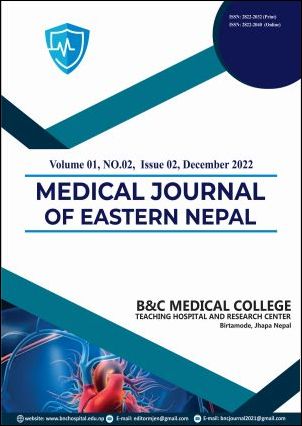Titanium Elastic Nailing (TEN) for Pediatric Long Bone Fractures: A Retrospective Institutional Experience
DOI:
https://doi.org/10.3126/mjen.v1i02.51161Keywords:
Bone remodeling, Diaphyseal fractures, Titanium Elastic Nail (TEN)Abstract
Background Titanium Elastic Nail (TEN) is used for fixation of diaphyseal fractures of paediatric long bone, where the medullary canal is thin or flexibility of the implant is a chief concern. These are used for biologically and minimally invasive fracture treatment that delivers accurate reduction and stabilization in appropriate paediatric age group
Methods A hospital based 18 months (from December 2020 to July 2022), retrospective study was conducted at Devdaha Medical College and Research Institute, Rupandehi, Nepal with the patients of paediatric long bone fractures who were operated with an elastic titanium intramedullary nail for diaphyseal fractures. Records of the surgical procedure and the follow-up outcomes were all recorded and the data was collected and tabulated in excel sheet for statistical analysis. The total number of patients in the study were 25 wherein, 20 were male and 5 were female.
Results Children ranging from age 4 to 15 years of age were included with mean age of 9.44 years. Average hospital stay was 4 days having standard deviation of 1.68. Statistical analysis yielded z value of 2.97 and p-value of 0.003 which was significant. Most of the patients reported injury in the left side 17(68%) than right side 8(32%). Majority of the injury was sustained in forearm 18(72%) followed by femur 4(16%) and tibia 3(12%). Fall on the ground 14(56%) was commonest mode of injury followed by road traffic accident (RTA) 5(20%), fall from tree 3(12%), fall from bicycle 2(8%) and sports injury 1(4%) respectively. The average time to fracture union was 9.84 ± 2.93 weeks. Only 4 patients had complication, in which 2 had superficial surgical site infection and no
patient had Limb Length Discrepancy or non-union.
Conclusion TENS for diaphyseal fracture is not only a safe, minimally invasive technique with shorter operating time but also helps in preservation of accurate bone alignment and encourages quicker bone healing.
Downloads
Downloads
Published
How to Cite
Issue
Section
License
Copyright (c) 2022 B & C Medical College and Teaching Hospital and Research Centre

This work is licensed under a Creative Commons Attribution 4.0 International License.
CC BY: This license allows reusers to distribute, remix, adapt, and build upon the material in any medium or format, so long as attribution is given to the creator. The license allows for commercial use.




